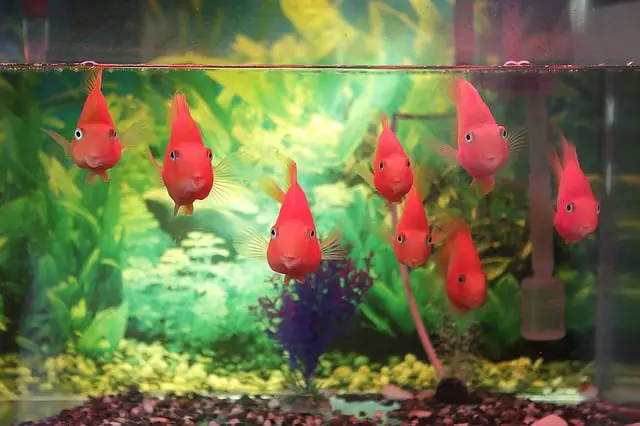When considering a fish tank, you need to weigh the pros and cons of glass versus acrylic. With so many options available, it’s recommended that you do your research beforehand to ensure you’re getting the right tank for your aquarium needs. One question typically asked is which type lasts the longest? And the answer is…
On average, glass fish tanks tend to last longer than acrylic aquariums. The average lifespan for a glass tank is 10 to 20 years whereas an acrylic version is somewhere between 5 and 15 years – if they’re properly maintained and under the right physical circumstances, that is. Many factors affect how long a fish tank lasts such as placement, ultraviolet light, and structural integrity.
Now that you know glass tanks tend to last longer than acrylic ones, let’s explore this topic further. As we move through this article, I’ll explain the pros and cons of each as well as which one is ‘better’, in my opinion. I’ll also discus where to buy fish tanks as well as replacement aquarium glass. I’ll even include some helpful hints on how to make your tank last as long as possible.
So, if you’re ready to learn more about glass versus acrylic fish tanks so you can make the most informed choice possible, then let’s get started!
Which is Better for an Aquarium Glass or Acrylic?
As far as which type is better, that depends on you and your needs as an aquarium hobbyist. If longevity is your main concern, then a glass tank is the better choice. If you prefer a lightweight aquarium, then an acrylic version is the one for you. I personally prefer a glass over an acrylic tank as they’re often cheaper, last longer and allow for better viewing.
What are the Pros and Cons of Glass Aquariums?
The pros of glass aquariums include:
- less expensive to purchase
- scratch-resistant
- stronger panels
- won’t turn yellow
- non-porous design
- less visible distortion
- damaged seals can often be repaired
The cons of glass aquariums include:
- heavier overall
- limited design shapes/styles
- harder to transport
As you can see, there are more advantages than disadvantages to choosing a glass aquarium over an acrylic one. Glass tank are cheaper to purchase and last longer. They also won’t discolor from exposure to ultraviolet light nor will they lose their clarity – both of which make for better viewing. The only real downside is the added weight and the lack of style options.
Check out these glass aquariums available online through Amazon.

What are the Pros and Cons of Acrylic Aquariums?
The pros of acrylic aquariums include:
- lightweight design
- more shape/style options
- easier to transport
The cons of acrylic aquariums include:
- more expensive to purchase
- scratches easily
- prone to design flaws
- panels can turn yellow
- porous and absorbs chemicals
- higher visual distortion
- damaged seals are more difficult to repair
As you can see, there are more disadvantages than advantages when it comes to an acrylic aquarium. Though lighter and easier to transport, they’re also quite costly. The greater choice of style and shape options in no way compensates for the lack of clarity. Acrylic tanks are porous and absorb chemicals as well as ultraviolet light, thus weakening the structure and making them appear yellow over time.
Check out these acrylic aquariums available online through Amazon.
Is Acrylic Safe for Fish Tanks?
Both the material and paint used for designing and decorating acrylic fish tanks are safe and non-toxic. Where acrylic tanks can become dangerous results from the porosity of the material. They can absorb both chemicals and ultraviolet light which affects their structural integrity. Over time, these tanks become brittle and weak and well as turn yellow.
Can Acrylic Fish Tanks Break?
Though acrylic fish tanks are more resistant to breakage than glass tanks, they can still crack if hit too hard. Over time, the poly material becomes weak and brittle – turning yellow and hazy after prolonged subjection to sunlight or aquarium lighting. Therefore, it’s recommended that you place your acrylic tank in a location with less ‘traffic’ and limited exposure to ultraviolet light.
How Long Do Glass Fish Tanks Last?
Glass fish tanks can last for decades if properly cared for and the structure is intact. Though 10 years is the average, it’s not unheard of for a well-maintained glass aquarium to last 20 years or even more. In most cases, glass tanks over 10 years old need resealing, which you can do yourself after you’ve taken it down and emptied it completely.
How Long Do Acrylic Aquariums Last?
Acrylic tanks don’t tend to last as long as glass aquariums. However, if the structure is sound and it’s well-maintained, you should be able to get a good 5 to 15 years of use from one. Unlike glass tanks, acrylic versions are less susceptible to breaking or cracking and they don’t require resealing as they get older. In fact, attempting to reseal an acrylic tank will only weaken the seams even further.
How to Make Your Glass Aquarium Last Longer?
To maximize the life span of your glass aquarium, make sure to properly maintain it. Keep the tank away from high traffic areas where it can easily get bumped. If hit hard enough, the unit may crack. As well, place it on an even surface with a sturdy stand that supports and balances the weight of the tank.
In addition, should you notice any leaking seems, you must reseal them immediately. Otherwise, you run the risk of the tank breaking. This will not only flood your home and cause significant damage – depending on the size of your tank, that is – but it will also result in the death of your aquatic pets!
How to Make Your Acrylic Aquarium Last Longer?
To ensure you get the longest life possible out of your acrylic fish tank, ensure you keep in a place where it won’t get bumped. As well, don’t leave it sitting in front of a window everyday during peak sunlight hours as overexposure to ultraviolet light will weaken the structure and turn the panels yellow.
And finally, don’t use harsh chemicals when cleaning your acrylic aquariums as the poly material is porous and will absorb these toxins. This not only affects the structural integrity of the unit itself, but it can also be dangerous for fish and other tank inhabitants.
Why are Acrylic Tanks so Expensive?
Acrylic fish tanks are often more expensive than their glass counterparts. The reason isn’t necessarily because the poly material is better than glass – though it may be, in some cases – but rather the cost to ship it is higher. Since transport costs factor into the final price, whether you purchase a tank directly from the supplier or from your local pet shop, you can expect to pay more for an acrylic aquarium.
Where to Buy Aquarium Glass?
Replacing cracked or broken aquarium glass is merely a click away! Most online aquarium suppliers sell replacement glass panels as well as local fish stores. With the right glass and the proper tools (as well as some step-by-step instructions), you can repair a damaged panel on your own in no time!
Consider tempered glass aquariums whenever possible. Not only do they make the bottom of the tank more stable, but they’re also less prone to breakage. Tempered glass aquariums can also support more water mass as well as the added weight from substrate and rocks which makes them a safer option.
Conclusion
To conclude, glass fish tanks usually last years longer than acrylic aquariums. Instead of the typical 5 to 15 years for acrylic tanks, glass versions can last anywhere from 10 to 20 years – though both have the potential to last even longer with the proper care. There are multiple factors that affect how long a fish tank lasts including placement, exposure to ultraviolet light, and overall structural integrity.
I hope this article has answered your questions and helped you in choosing a glass or acrylic fish tank. Thanks for reading and best of luck with your aquarium hobby.
Related Posts
Seaclear 50 Gallon Acrylic Aquarium Review
Why Do Fish Tanks Crack? [2 Causes Identified]




